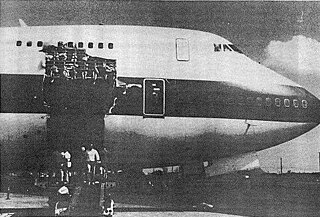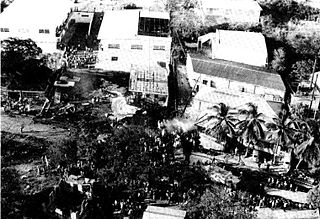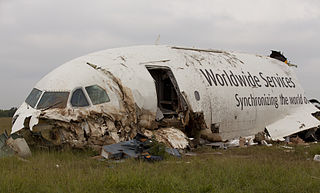
American Airlines Flight 191 was a regularly scheduled domestic passenger flight in the United States operated by American Airlines from O'Hare International Airport in Chicago, Illinois, to Los Angeles International Airport in Los Angeles, California. On the afternoon of May 25, 1979, the McDonnell Douglas DC-10-10 operating this flight was taking off from runway 32R when its left engine detached, causing loss of control, and it crashed less than a mile (1.6 km) from the end of the runway. All 258 passengers and 13 crew on board were killed, along with two people on the ground. With 273 fatalities, it is the deadliest aviation accident to have occurred in the United States.

Delta Air Lines Flight 1141 was a scheduled domestic passenger flight between Dallas/Fort Worth, Texas and Salt Lake City, Utah. On August 31, 1988, the flight, using a Boeing 727-200 series aircraft, crashed during takeoff, resulting in 14 deaths and 76 injuries of the 108 people on board.

United Airlines Flight 232 was a regularly scheduled United Airlines flight from Stapleton International Airport in Denver to O'Hare International Airport in Chicago, continuing to Philadelphia International Airport. On July 19, 1989, the DC-10 serving the flight crash-landed at Sioux City, Iowa, after suffering a catastrophic failure of its tail-mounted engine due to an unnoticed manufacturing defect in the engine's fan disk, which led to the loss of many flight controls. Of the 296 passengers and crew on board, 112 died during the accident, while 184 people survived. Despite the deaths, the accident is considered a prime example of successful crew resource management because of the large number of survivors and the manner in which the flight crew handled the emergency and landed the airplane without conventional control. It is also the deadliest accident in the history of United Airlines.

Northwest Airlines Flight 255, a McDonnell Douglas MD-82, crashed shortly after takeoff from Detroit Metropolitan Airport on August 16, 1987, about 8:46 pm EDT, resulting in the deaths of all six crew members and 148 of its 149 passengers, along with two people on the ground. The sole survivor was a 4-year-old girl who sustained serious injuries. It was the second-deadliest aviation accident at the time in the United States. It is also the deadliest aviation accident to have a sole survivor.

A flight recorder is an electronic recording device placed in an aircraft for the purpose of facilitating the investigation of aviation accidents and incidents. Flight recorders are also known by the misnomer black box—they are, in fact, painted bright orange in color to aid in their recovery after accidents.

SilkAir Flight 185 was a scheduled passenger flight operated by a Boeing 737-300 from Soekarno–Hatta International Airport in Jakarta, Indonesia to Changi Airport in Singapore that crashed into the Musi River near Palembang, Sumatra on 19 December 1997, killing all 97 passengers and seven crew on board.

United Airlines Flight 585 was a scheduled passenger flight on March 3, 1991 from Denver to Colorado Springs, Colorado, carrying 20 passengers and 5 crew members on board. The plane experienced a rudder hardover while on final approach to runway 35 at Colorado Springs Municipal Airport, causing the plane to roll over and enter an uncontrolled dive. All 25 people onboard were killed.

United Airlines Flight 811 was a regularly scheduled airline flight from Los Angeles to Sydney, with intermediate stops at Honolulu and Auckland. On February 24, 1989, the Boeing 747-122 serving the flight experienced a cargo-door failure in flight shortly after leaving Honolulu. The resulting explosive decompression blew out several rows of seats, resulting in the deaths of nine passengers. The aircraft returned to Honolulu and landed with no further incident.

American Airlines Flight 625, a Boeing 727-100, crashed at St. Thomas, U.S. Virgin Islands on April 27, 1976, while on a domestic scheduled passenger flight originating at T. F. Green Airport in Rhode Island and ending at Saint Thomas, United States Virgin Islands, with an intermediate stop at John F. Kennedy International Airport. 37 out of the 88 passengers on board died in the accident.

Piedmont Airlines Flight 22, a Piedmont Airlines Boeing 727-22 and a twin-engined Cessna 310 collided on July 19, 1967, over Hendersonville, North Carolina, United States. Both aircraft were destroyed and all passengers and crew were killed, including John T. McNaughton, an advisor to Robert McNamara. The aircraft were both operating under instrument flight rules and in radio contact with the Asheville control tower, though on different frequencies. The accident investigation carried out in the aftermath of the crash was the first major investigation ever conducted by the newly created National Transportation Safety Board. A review of the investigation, conducted 39 years after the crash, upheld the original findings that had placed primary responsibility on the Cessna pilot.
TWA Flight 841 was a domestic, scheduled passenger flight from John F. Kennedy International Airport in New York City, en route to Minneapolis-Saint Paul International Airport in Minneapolis, Minnesota. On April 4, 1979, at or around 9:48 p.m. Eastern Standard Time, while flying over Saginaw, Michigan, the Boeing 727-31 airliner began a sharp, uncommanded roll to the right, and subsequently went into a spiral dive. The pilots were able to regain control of the aircraft and made a successful emergency landing at Detroit Metropolitan Airport.

Alaska Airlines Flight 1866 was a regularly scheduled passenger flight operated by Alaska Airlines from Anchorage, Alaska, to Seattle, Washington, with several intermediate stops in southeast Alaska. The aircraft was a Boeing 727-100 with U.S. registry N2969G manufactured in 1966. On September 4, 1971, the aircraft operating the flight crashed into a mountain in Haines Borough, about 18 miles west of Juneau, Alaska, while on approach for landing. All 111 people aboard were killed. The subsequent investigation found that erroneous navigation readouts led the crew to descend prematurely. No definitive cause for the misleading data was found. It was the first fatal jet aircraft crash involving Alaska Airlines, and remained the deadliest single-aircraft accident in United States history until June 24, 1975, when Eastern Air Lines Flight 66 crashed.
During the 1990s, a series of issues affecting the rudder of Boeing 737 passenger aircraft resulted in multiple incidents. In two separate accidents, pilots lost control of their aircraft due to a sudden and unexpected rudder movement, and the resulting crashes killed everyone on board, 157 people in total. Similar rudder issues led to a temporary loss of control on at least one other Boeing 737 flight before the problem was ultimately identified.

On 15 December 1989, KLM Flight 867, en route from Amsterdam to Narita International Airport Tokyo, was forced to make an emergency landing at Anchorage International Airport, Alaska, when all four engines failed. The Boeing 747-400 combi, less than six months old at the time, flew through a thick cloud of volcanic ash from Mount Redoubt, which had erupted the day before.

EgyptAir Flight 990 (MS990/MSR990) was a regularly scheduled flight from Los Angeles International Airport to Cairo International Airport, with a stop at John F. Kennedy International Airport, New York City. On October 31, 1999, the Boeing 767-300ER operating the route crashed into the Atlantic Ocean about 60 miles (100 km) south of Nantucket Island, Massachusetts, killing all 217 passengers and crew on board.

USAir Flight 427 was a scheduled flight from Chicago's O'Hare International Airport to Palm Beach International Airport, Florida, with a stopover at Pittsburgh International Airport. On Thursday, September 8, 1994, the Boeing 737 flying this route crashed in Hopewell Township, Pennsylvania while approaching Runway 28R at Pittsburgh, which at the time was the airline's largest hub.

Provincetown-Boston Airlines Flight 1039 was a scheduled passenger flight from Jacksonville International Airport in Jacksonville, Florida, to Tampa International Airport, Florida. On December 6, 1984, the plane crashed upon takeoff at Jacksonville, killing all 13 passengers and crew.

UPS Airlines Flight 1354 was a scheduled cargo flight from Louisville, Kentucky, to Birmingham, Alabama. On August 14, 2013, the Airbus A300 flying the route crashed and burst into flames short of the runway on approach to Birmingham–Shuttlesworth International Airport. Both pilots were pronounced dead at the scene of the crash. They were the only people aboard the aircraft. It was the second fatal air crash for UPS Airlines.

Atlas Air Flight 3591 was a scheduled domestic cargo flight operating for Amazon Air between Miami International Airport and George Bush Intercontinental Airport in Houston. On February 23, 2019, the Boeing 767-375ER(BCF) used for this flight crashed into Trinity Bay during approach into Houston, killing the two crew members and one passenger on board. The accident occurred near Anahuac, Texas, east of Houston, shortly before 12:45 CST (18:45 UTC). This was the first fatal crash of a Boeing 767 freighter.

Tower Air Flight 41 was a scheduled domestic passenger flight from John F. Kennedy International Airport (JFK) in New York City, to Miami International Airport (MIA) in Florida. On December 20, 1995, the Boeing 747-100 operating the flight veered off the runway during takeoff from JFK. All 468 people on board survived, but 25 people were injured. The aircraft was damaged beyond repair and written off, making the accident the 25th hull loss of a Boeing 747. The National Transportation Safety Board (NTSB) concluded that the captain had failed to reject the takeoff in a timely manner.


















